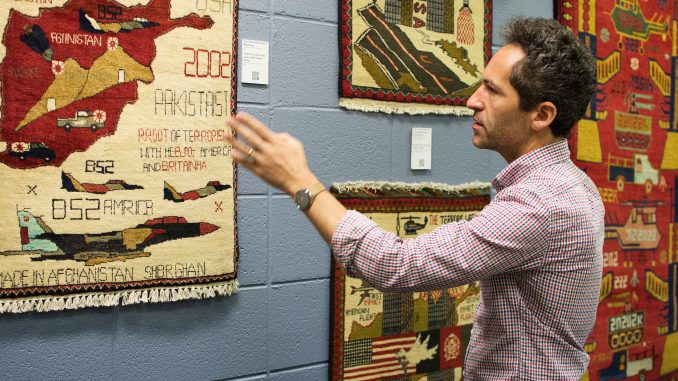
Kevin Sudeith first became interested in war rugs when he saw one at a dinner party in graduate school, while studying fine art at the School of Visual Arts in New York City.
After entering “a wealthy, Italian industrialist house,” Sudeith said he was struck by a piece by Alighiero Boetti, an artist who had pieces created in Afghanistan, and was largely responsible for introducing war rugs to the Italian market. The rug with Qur’anic script had tanks, rifles and grenades laid on top of a yellow field surrounded by a red-and-black border.
“I had never seen anything like it, and it was amazing, quite frankly,” Sudeith said.
Sudeith then became interested in using rugs as a medium for contemporary art, especially because they often serve as historical documentation.
“There’s so little first-hand reporting that comes out of the conflict, and these are a special document from people who are involved in conflict,” Sudeith said. “The war in Afghanistan is still boiling pretty hard, and it’s important we understand and are aware of that.”
Sudeith’s collection is composed of more than 200 war rugs, primarily pieces dating from the 1980s to present day. He recently loaned 14 of these rugs to Paley Library for an exhibit titled, “Outside In: Violence and Expression in Afghan War Rugs,” which will run through March in room 309.

Ilana Napoli, an assistant curator for the exhibition, said studying Afghan war rugs helps contextualize a group of people that many Americans know very little about.
“What’s really important to me is showing experiences of violence and how they’ve had to cope through the perspective of sympathizing with Afghan people, and not viewing it from a U.S. military perspective and generalizing,” the junior visual studies major said.
The rugs displayed at the exhibition portray a variety of scenes, ranging from depictions of the Soviet-Afghan War to the attacks on the U.S. World Trade Center—all from the perspective of Afghan weavers.
Alicia Cunningham-Bryant, associate director for special programs and assistant professor in the Intellectual Heritage department, said she believes the war rugs can also create a discussion about America’s political and social standings in “a really emotional way.”
“I think it’s a particularly interesting time to not just look at Afghanistan, but to look at our interactions with foreign powers around the world,” said Cunningham-Bryant, the exhibition’s curator. “We’re having a very contentious debate about the immigrant and migrant population in Europe and what’s happened in Syria and the destabilization of the regime there. We’ve seen a lot of reactionary discussions on our end on America’s foreign and domestic policies in regard to this situation.”
“And I think what tends to get lost in those narratives and discussions is the experience of those living it,” she added. “Our foreign policy absolutely dictates a large portion of their lives.”

Despite the fact that English was typically the weavers’ second or third language, much of the text on the rugs is in English.
“It’s their way of sharing their side,” said Rachel Morin, an intern/assistant curator and junior visual studies and advertising major. “The terrorist groups give other people a really bad reputation and a really bad name, and it creates this sense of fear among certain groups of people, especially right now as part of the Islamophobia, and certain political leaders are definitely not helping that cause.”
“These rugs are evidence of basically the underdogs or survivors of what happened, and it’s their point of view,” she added.
Cunningham-Bryant said the exhibition is especially relevant for Temple students due to the university’s diverse student body, strong ROTC program and high veteran population.
“It really seemed like something we should get interested in, invested in and learn more about,” she said.
Napoli also feels passionate about the cultural exposure the war rugs will provide.
“I want to bring to people’s attention the fact that in America there are many misconceptions about the lives of people in Afghanistan in regards to what they believe, the lives they lead and what they experience,” Napoli said. “I just really want to show that there’s more to the story than what you learn about.”
Students can view the rugs on display during specific hours listed at the University Libraries’ website and can register to view the exhibition through the event’s Ticketleap page.
Jenny Stein can be reached at jenny.stein@temple.edu.
Video by Caroline Vana.


Be the first to comment